Microsoft Bundle
How Does Microsoft Thrive in Today's Tech World?
Microsoft, a global technology leader, consistently demonstrates its strength with impressive financial results, like its $61.9 billion revenue in Q3 FY2024, a 17% increase year-over-year. Its influence spans diverse sectors, from enterprise solutions to consumer entertainment, solidifying its position as a technology cornerstone. Understanding Microsoft SWOT Analysis is crucial for anyone seeking to navigate the complexities of this tech giant.
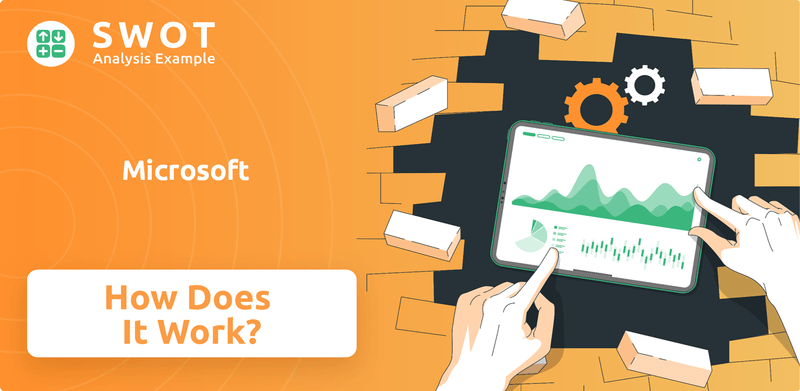
The company's strategic focus on cloud computing, especially with Azure, fuels its success, with Azure's revenue growing by 31% in Q3 2024. This shift highlights Microsoft's agility in capturing new market opportunities, reinforcing its position as a critical player in the digital transformation. Exploring How Microsoft works, its operational framework, and monetization strategies reveals a sophisticated ecosystem designed for sustained growth and market leadership, offering valuable insights.
What Are the Key Operations Driving Microsoft’s Success?
The core operations of the Microsoft company revolve around creating and delivering value through a diverse portfolio of products and services. These offerings primarily cater to enterprise clients, developers, and individual consumers. Key components include the Windows operating system, the Microsoft 365 suite, Azure cloud computing services, Dynamics 365 business applications, LinkedIn, and the Xbox gaming platform. These operations are deeply rooted in extensive research and development, particularly in software engineering and cloud infrastructure, ensuring the continuous evolution and improvement of its products.
Microsoft's value proposition centers on providing integrated, scalable, and secure technology solutions. These solutions are designed to enhance productivity, facilitate collaboration, and drive digital transformation for its users. The company's operational backbone relies on a vast network of data centers worldwide to support its cloud services. Sales channels include direct sales, online stores, and a global network of partners and resellers, ensuring broad accessibility to its products and services.
The company's supply chain for hardware products, such as Surface devices and Xbox consoles, involves global manufacturing and logistics networks. Customer service is delivered through a combination of online support, self-service resources, and dedicated enterprise support teams. The synergy between its operating systems, productivity software, and cloud services creates a powerful network effect, making its offerings more valuable as more users adopt them. This integrated approach translates into significant customer benefits, such as seamless workflow across devices and platforms, enhanced security, and access to a comprehensive suite of tools for various business needs. Understanding how Microsoft works is key to appreciating its market position.
Microsoft invests heavily in research and development (R&D) to innovate and improve its products. This includes software engineering, cloud infrastructure, and artificial intelligence. In fiscal year 2024, Microsoft's R&D expenses were approximately $29.6 billion, demonstrating its commitment to future technologies.
Azure's global network of data centers is critical for delivering cloud services. These data centers ensure high availability, reliability, and low latency. Microsoft has a significant presence in the cloud market, with Azure holding a substantial market share, though specific percentages fluctuate based on the latest reports.
Microsoft uses direct sales, online stores, and a global network of partners and resellers. This multi-channel approach ensures broad market reach. The company's sales and marketing efforts are crucial for promoting its products and services to various customer segments.
Customer service is provided through online support, self-service resources, and dedicated enterprise support teams. Microsoft aims to provide comprehensive support to address customer needs effectively. The company's support infrastructure is designed to handle a large volume of inquiries.
Microsoft's operations are unique due to their scale and interconnectedness, creating a powerful network effect. The integration of its operating systems, productivity software, and cloud services enhances customer benefits. Understanding the Microsoft structure is key to appreciating its market position.
- Research and Development: Continuous investment in innovation.
- Global Infrastructure: Extensive data center network for cloud services.
- Multi-Channel Sales: Diverse sales and distribution strategies.
- Customer Support: Comprehensive support resources for users.
Microsoft SWOT Analysis
- Complete SWOT Breakdown
- Fully Customizable
- Editable in Excel & Word
- Professional Formatting
- Investor-Ready Format
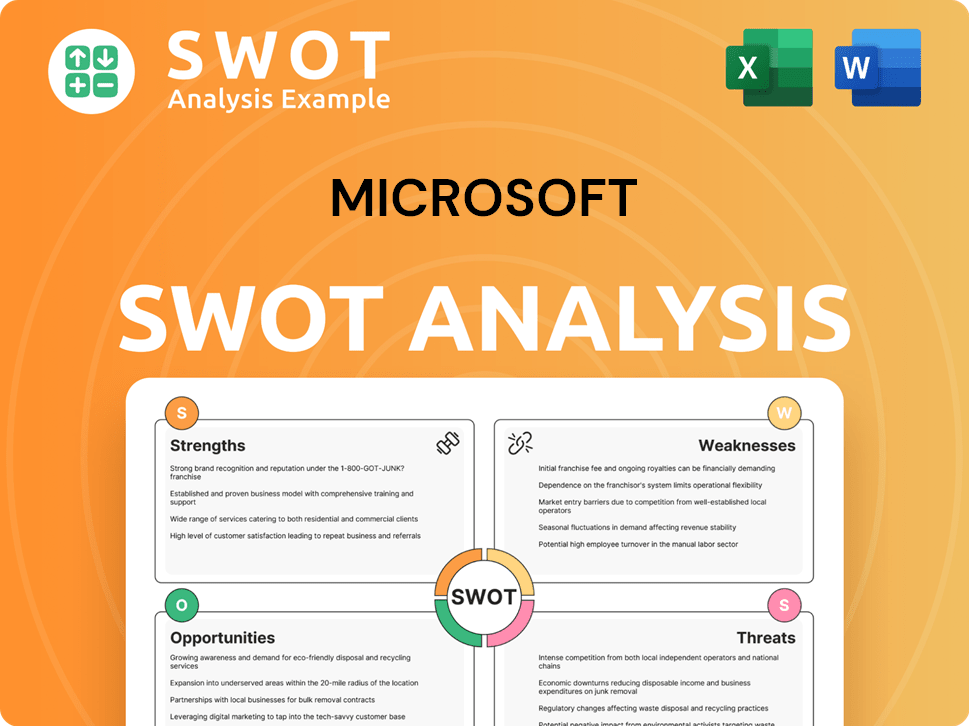
How Does Microsoft Make Money?
The Microsoft company operates with diverse revenue streams and strategic monetization methods. The company's financial success is driven by a shift towards recurring revenue models, reflecting its adaptability in the tech industry. This approach ensures a more predictable and stable income flow.
For the third quarter of fiscal year 2024, Microsoft's total revenue reached $61.9 billion. The company's revenue is primarily generated through three key segments: Productivity and Business Processes, Intelligent Cloud, and More Personal Computing. These segments showcase the breadth of Microsoft's business operations and its ability to cater to various market needs.
The Intelligent Cloud segment, which includes Azure, server products, and enterprise services, is a significant growth driver for Microsoft. In Q3 2024, this segment saw a 21% increase in revenue, reaching $26.7 billion. This growth highlights the increasing importance of cloud services to Microsoft's overall financial performance and its strategic focus on cloud computing.
The Productivity and Business Processes segment, which includes Office 365, LinkedIn, and Dynamics 365, generated $19.6 billion in revenue in Q3 2024. Microsoft employs various monetization strategies to maximize revenue and customer engagement.
- Subscription models are central to Microsoft's strategy, particularly for Microsoft 365 and Azure. These subscriptions provide recurring revenue and encourage customer loyalty.
- Licensing of software products remains a revenue source, though the company is increasingly focused on subscription-based models.
- Hardware sales, including devices like Surface and Xbox, contribute to revenue, expanding Microsoft's presence in the consumer market.
- Advertising revenue from platforms like LinkedIn and search also plays a role in the company's financial performance.
- Tiered pricing for cloud services and bundled offerings for its productivity suite encourage greater adoption and higher average revenue per user.
- Cross-selling is a key strategy for Microsoft, leveraging its extensive customer base to introduce new services and products.
Microsoft PESTLE Analysis
- Covers All 6 PESTLE Categories
- No Research Needed – Save Hours of Work
- Built by Experts, Trusted by Consultants
- Instant Download, Ready to Use
- 100% Editable, Fully Customizable
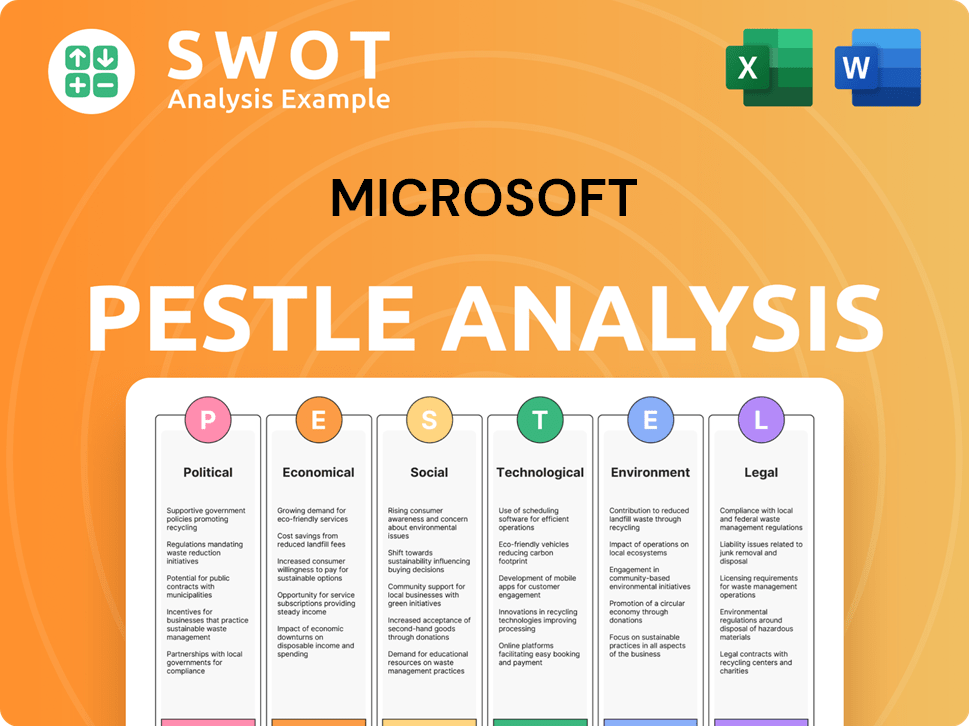
Which Strategic Decisions Have Shaped Microsoft’s Business Model?
The journey of the Microsoft company has been marked by significant milestones and strategic shifts that have fundamentally shaped its operations and financial performance. From its early days in personal computing to its current position as a leader in cloud services, Microsoft has consistently adapted to market changes. Key moves, such as the acquisition of LinkedIn and GitHub, have broadened its reach and capabilities, while its ongoing investments in AI reflect its commitment to innovation.
Microsoft's strategic decisions have been crucial in navigating challenges and maintaining its competitive edge. The company has faced antitrust scrutiny and intense competition, responding with substantial investments in research and development, strategic acquisitions, and a focus on customer needs. These actions have solidified its market position and fueled its growth.
The company's competitive advantages are multifaceted, including a strong brand, a vast ecosystem of products and services, and technological leadership in areas like AI and cloud computing. The extensive network of developers and partners contributes to its strength. Microsoft continues to adapt to new trends, integrating AI capabilities across its product portfolio and maintaining a robust financial position to navigate competitive threats and lead the market.
The launch of Windows in the 1980s established Microsoft's dominance in personal computing. The strategic pivot towards internet services in the late 1990s and early 2000s laid the groundwork for future online ventures. The acquisition of LinkedIn in 2016 and GitHub in 2018 expanded its reach in professional networking and developer communities, respectively.
A key strategic move was the aggressive push into cloud computing with Azure, which has diversified revenue streams. The acquisition of Activision Blizzard, completed in October 2023, significantly bolstered its position in the gaming industry. Microsoft continually adapts to new trends, such as the increasing demand for AI-powered solutions, by integrating AI capabilities across its product portfolio.
Microsoft's competitive advantages include brand strength, a deeply entrenched ecosystem, and technological leadership in AI and cloud computing. The company benefits from massive economies of scale and an extensive network of developers and partners. Its ability to adapt to new trends, such as the increasing demand for AI-powered solutions, strengthens its market position.
In fiscal year 2024, Microsoft reported revenue of $236.6 billion, a 14% increase year-over-year. The company's net income for the same period was $85.1 billion. The Intelligent Cloud segment saw a revenue increase of 19%, driven by Azure and other cloud services. These figures highlight Microsoft's robust financial performance and continued growth in key areas.
Microsoft's future plans and strategies involve continued investment in AI, cloud computing, and expanding its presence in the gaming market. The company aims to integrate AI capabilities across its product portfolio, enhancing user experiences and driving innovation. These strategic moves are designed to maintain its market leadership and capitalize on emerging opportunities.
- Continued investment in AI and cloud computing to drive innovation.
- Expansion of its presence in the gaming market through strategic acquisitions.
- Focus on customer-centricity and open platforms to enhance user experiences.
- Adaptation to new trends, such as the increasing demand for AI-powered solutions.
Microsoft Business Model Canvas
- Complete 9-Block Business Model Canvas
- Effortlessly Communicate Your Business Strategy
- Investor-Ready BMC Format
- 100% Editable and Customizable
- Clear and Structured Layout
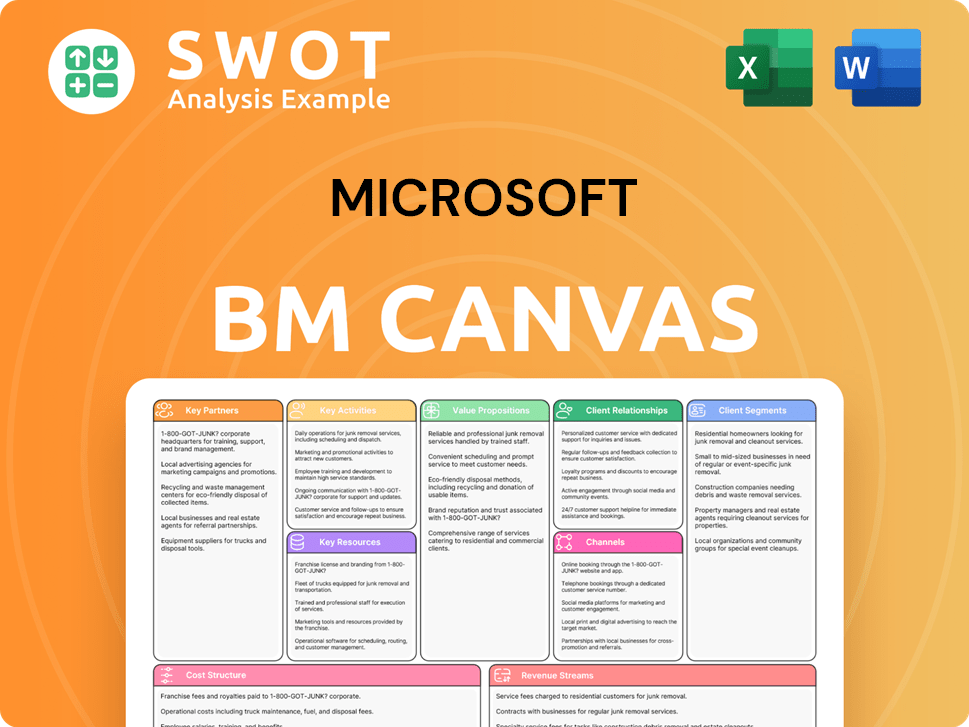
How Is Microsoft Positioning Itself for Continued Success?
The Microsoft company holds a significant position in the technology industry, competing with giants like Amazon, Google, and Apple. Its dominance in operating systems with Windows and its growing cloud presence with Azure are key strengths. Customer loyalty and a global reach further solidify its market position, making it a key player in the tech landscape.
However, How Microsoft works is also subject to several risks. These include regulatory pressures, intense competition, technological disruptions like AI advancements, and shifts in consumer behavior. Adapting to these challenges is crucial for the company's continued success and market share.
Microsoft maintains a strong position in multiple tech sectors, often competing with major players. Its Windows operating system continues to dominate the market. Azure is rapidly gaining ground in the cloud infrastructure market.
The company faces risks such as regulatory changes, intense competition, and technological disruptions. Shifting consumer preferences and economic downturns also pose challenges. These factors could impact demand for its products and services.
Microsoft's future is focused on artificial intelligence, cloud expansion, and gaming. The company is heavily investing in Azure infrastructure and services. Leadership emphasizes responsible AI development and empowering customers.
Key initiatives include integrating AI across its product stack and expanding Azure. Strategic acquisitions and market penetration are also crucial. The aim is to sustain and expand revenue through innovation.
Microsoft is heavily investing in AI, cloud services, and gaming to drive future growth. The company is integrating AI across its product stack, including Microsoft 365 Copilot. Continued investment in Azure is central to its strategy.
- Microsoft's revenue for fiscal year 2024 was approximately $220 billion.
- Azure's revenue growth rate in the most recent quarter was around 31%.
- The company is focused on expanding its cloud services and AI capabilities.
- For more insights into its strategic approach, consider reading about the Growth Strategy of Microsoft.
Microsoft Porter's Five Forces Analysis
- Covers All 5 Competitive Forces in Detail
- Structured for Consultants, Students, and Founders
- 100% Editable in Microsoft Word & Excel
- Instant Digital Download – Use Immediately
- Compatible with Mac & PC – Fully Unlocked
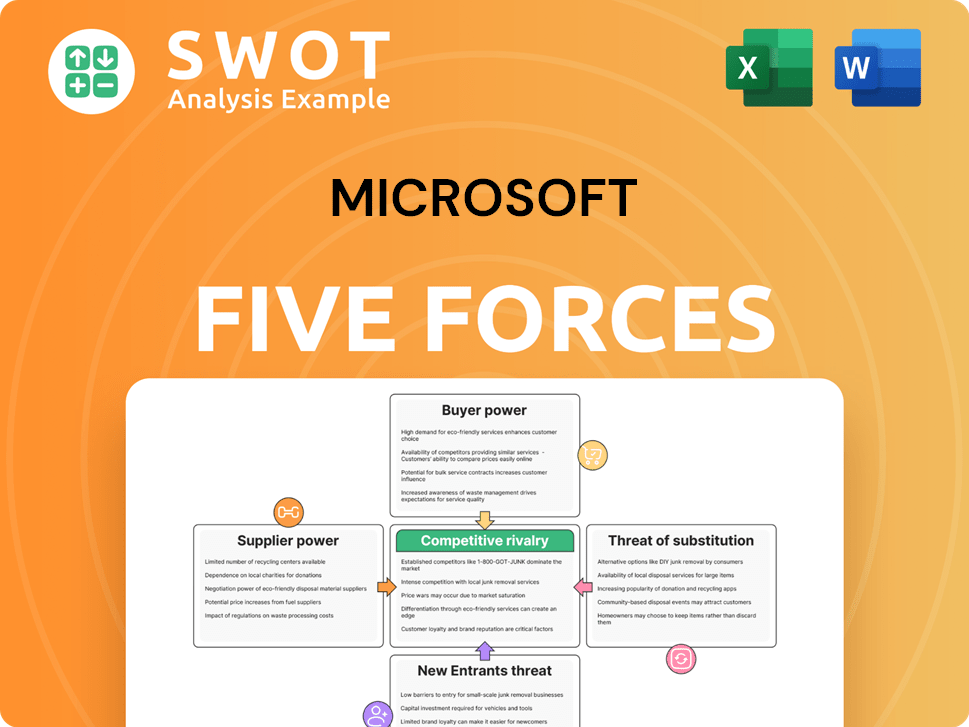
Related Blogs
- What are Mission Vision & Core Values of Microsoft Company?
- What is Competitive Landscape of Microsoft Company?
- What is Growth Strategy and Future Prospects of Microsoft Company?
- What is Sales and Marketing Strategy of Microsoft Company?
- What is Brief History of Microsoft Company?
- Who Owns Microsoft Company?
- What is Customer Demographics and Target Market of Microsoft Company?
Disclaimer
All information, articles, and product details provided on this website are for general informational and educational purposes only. We do not claim any ownership over, nor do we intend to infringe upon, any trademarks, copyrights, logos, brand names, or other intellectual property mentioned or depicted on this site. Such intellectual property remains the property of its respective owners, and any references here are made solely for identification or informational purposes, without implying any affiliation, endorsement, or partnership.
We make no representations or warranties, express or implied, regarding the accuracy, completeness, or suitability of any content or products presented. Nothing on this website should be construed as legal, tax, investment, financial, medical, or other professional advice. In addition, no part of this site—including articles or product references—constitutes a solicitation, recommendation, endorsement, advertisement, or offer to buy or sell any securities, franchises, or other financial instruments, particularly in jurisdictions where such activity would be unlawful.
All content is of a general nature and may not address the specific circumstances of any individual or entity. It is not a substitute for professional advice or services. Any actions you take based on the information provided here are strictly at your own risk. You accept full responsibility for any decisions or outcomes arising from your use of this website and agree to release us from any liability in connection with your use of, or reliance upon, the content or products found herein.